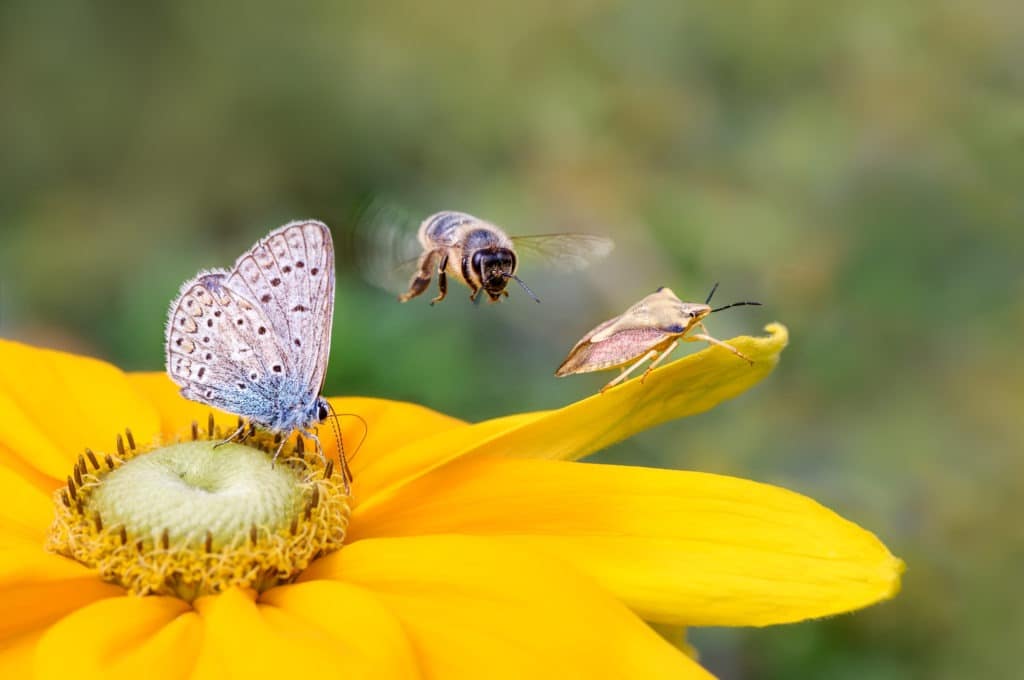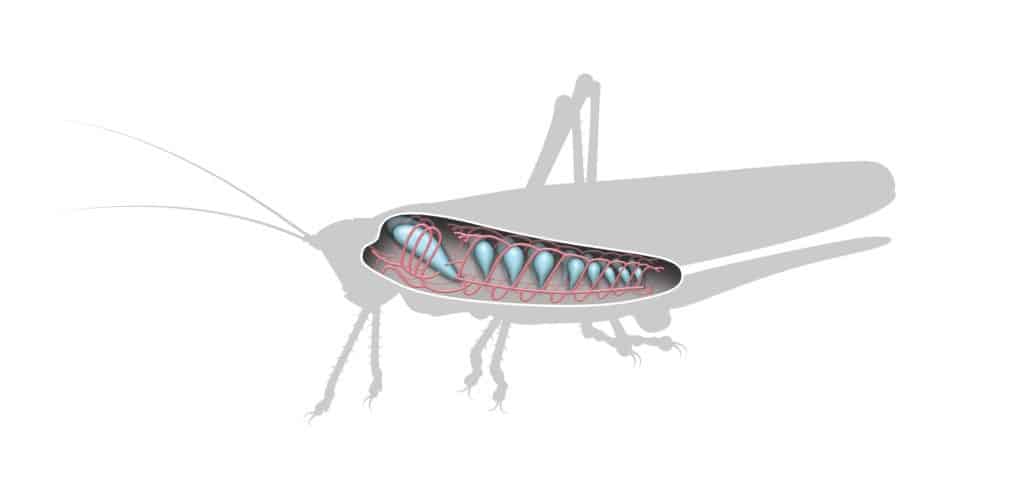Here’s the difference between insects and arthropods:
All insects are arthropods, though not all arthropods are insects.
These are the 9 key reasons why insects are arthropods, but not all arthropods are insects:
- Number of units (body segmentation)
- Composition of exoskeleton
- Number and location of legs
- Antennae
- Eyes
- Wings
- Metamorphosis and larval stages
- Respiratory system
- Excretory system
If you want to learn all about the differences between insects and arthropods, then you’ve come to the right place.
Let’s get started!
Is There a Difference Between Insects and Arthropods?

Imagine you see a:
- Butterfly
- Spider
- Lobster
- Centipede or Millipede
Most of us think of all of these as part of the same group of living organisms. You are partially correct. All of them are part of the phylum Arthropoda.
However, they are not the same.
- Butterflies—Insect
- Spider—Arachnid
- Lobster—Crustaceans
- Centipedes and Millipedes—Myriapoda
To most of us, the term “Insect” represents all the arthropods.
We get confused because we lump all of these organisms together even though most on this list are technically not insects.
Just remember: “All insects are arthropods, but all arthropods are not insects.”
To better understand the differences between insects and arthropods, let’s introduce some important terms and concepts.
What Are Arthropods?

The largest phylum of the kingdom Animalia is Arthropoda. To be called an arthropod, the organism must have the following characteristics:
- Jointed appendages.
- Chitinous (made of chitin), non-living, waxy, moisture-proof exoskeleton which serves the purpose of protection and to provide a place for muscle attachment. It is often hardened by the deposition of calcium or silica. The organism must shed its exoskeleton to grow as part of a process called molting. Exoskeleton gives rise to many appendages and projections modified for protection, predation, sperm injection, filtering food, sensing and communication, and much more.
- Segmented body; the number of segments can vary in different arthropods.
- Antennae are the modified projections made up of chitin use for sensing the environment and for communication.
- Compound eye is made up of specialized cells called Ommatidia, which detect the stimulus of eyes and rarely form an image different from ours.
- The main body cavity is called coelom and possesses bilateral summitry (i.e., the body can be cut into two mirror images using one plane only).
- An open circulatory system consisting of a tubular heart, blood-like fluid (hemolymph) with no red blood cells, and hemoglobin. Most arthropods don’t need to transport oxygen, but some have a blue-pigmented protein called hemocyanin dissolved in their hemolymph.
- The excretory system of arthropods is of two types: 1) Excretion through gills, as in aquatic arthropods; and 2) Excretion through Malpighian tubules, which are joined to the gut, as in terrestrial arthropods.
Arthropods are further divided into five major groups:
- Trilobites have been extinct since the Devonian Period.
- Chelicerata consisting of sea spiders, scorpions, spiders, ticks, mites, and horseshoe crab.
- Crustaceans are aquatic invertebrates such as shrimp, lobster, crabs, and woodlice.
- Hexapoda is comprised of insects and insect-like organisms.
- Myriapoda are centipedes and millipedes.
What Are Insects?

The above discussion clarifies that “Arthropods” consist of many broader groups, and insects are just one group within that larger group.
Although the total number of insects within Arthropoda is huge, they are still just a subdivision of arthropods.
Let’s discuss the differences between insects and other arthropods to better understand what makes insects distinctive.
What Are the Differences Between Insects and Arthropods? (9 Differences)
Here are the differences between insects and arthropods:
#1 Number of Units (Body Segmentation)

The body of an insect consists of three parts:
- Head
- Thorax (further divided into three segments)
- Abdomen (consists of 11 abdominal segments).
Other arthropods have a different body segmentation ranging from only two in arachnids to 15 to 170 segments found in centipedes.
#2 Composition of Exoskeleton

The second layer (procuticle) of the exoskeleton of insects is composed of chitin and sclerotin. But the exoskeleton of crustaceans contains magnesium calcite and amorphous calcium phosphate.
The difference in the composition is the result of evolutionary changes related to habitat and their niche specialization.
#3 Number and Location of Legs

Six legs in three pairs are the most important characteristic of insects and are attached to the thoracic segments only. Other arthropods have a variety of leg organization:
- 4 pairs in arachnids
- 5 pairs in some crustaceans
- Multiple pairs in centipedes and millipedes.
#4 Antennae

Antennae are the appendages attached to the head (the primary antennae) or, in some cases, the second segment (secondary antennae) in arthropods.
Insects have only one pair of antennae attached to the 2nd segment only and use them for a variety of purposes depending upon species:
- Olfactory sensation
- Taste sensation, as in the diamondback moth
- Mating as in African cotton leaf-worm
- As a compass, as in monarch butterflies.
Other arthropods, such as crustaceans, have 2 pairs of antennae which they use for sensation, communication, attachment, and even for swimming during larval stages.
Some arthropods don’t have antennae at all, such as spiders, mites, and scorpions.
#5 Eyes

Most insects have a dichoptic arrangement of the eyes, which means they have two eyes arranged on each side of their head.
Other arthropods may have a large number of eyes which have a variety of different arrangements such as a large number of the eyes arranged not only in the center of the head, but also on the sides and back of the head, as in the horseshoe crab.
#6 Wings

Insects are the only invertebrates that have developed the ability to fly. Their muscles are adapted to contract multiple times on a single nerve impulse (signal to contract).
All insects have developed a pair of wings that they can shed, but most fly during at least one phase of their life.
#7 Metamorphosis and Larval Stages

Normally, insects pass through four stages of development:
- Egg
- A mobile or immobile larva
- Pupa
- Adult
The developing insects in all these stages look different, and none of the stages look alike.
Although there is an incomplete metamorphosis, the larval stages of other arthropods are different from insects. For example, crustaceans pass through:
- Nauplius larval stage
- Zoea larval stage
- Mysis
- Post larval stage
- Adult growth stage
#8 Respiratory System

Insect respiratory system consists of a network of tubes called tracheae connected to the exterior through small openings on sides (spiracles).
The other arthropods also have trachea but have other respiratory systems such as gills and book lungs.
#9 Excretory System

Insects are the only group of invertebrates on Earth with an excretory system linked to their digestive system. They have blind-ended tubules called Malpighian tubules suspended in the body parenchyma (bulk of functional substance in an animal organ) and are attached to the gut (digestive system).
These tubules absorb nitrogenous wastes, convert them into uric acid and pour that uric acid into the gut destined to be expelled out along with undigested food.
Other groups of arthropods have different mechanisms for waste removal.
Crustaceans have antennal and maxillary glands for nitrogenous waste removal, and most of them excrete ammonia as the main excretory product. Centipedes also excrete waste products via Malpighian tubules.
After this thorough study of the differences between insects and other arthropods, you now know for certain that, “All insects are arthropods, but not all arthropods are insects.”
